
Best practice guidelines for executing a Case Challenge in a university setting. Why, for who, with who, how?
- Subject:
- Business and Communication
- Communication
- Material Type:
- Teaching/Learning Strategy
- Date Added:
- 05/13/2019

Best practice guidelines for executing a Case Challenge in a university setting. Why, for who, with who, how?
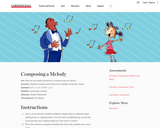
Students compose and notate short melodies using their names.
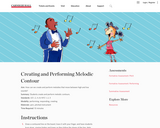
Students create and perform melodic contours.

This six-day lesson provides students with an introduction to the importance of energy in their lives and the need to consider how and why we consume the energy we do. The lesson includes activities to engage students in general energy issues, including playing an award-winning Energy Choices board game, and an optional graphing activity that provides experience with MS Excel graphing and perspectives on how we use energy and how much energy we use.

Students estimate the storage capacity of CDs and DVDs by assessing diffraction patterns of green and red laser beams.

Filtering is the process of removing or separating the unwanted part of a mixture. In signal processing, filtering is specifically used to remove or extract part of a signal, and this can be accomplished using an analog circuit or a digital device (such as a computer). In this lesson, students learn the impact filtering can have on different types of signals, the concepts of frequency and spectrum, and the connections these topics have to real-world signals such as musical signals. Students also learn the roles that these concepts play in designing different types of filters. The lesson content prepares students for the associated activity in which they use an online demo and a variety of filters to identify the message in a distress signal heavily corrupted by noise.
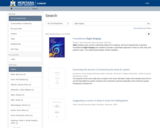
Sight reading music can be a daunting endeavor for aspiring, and even experienced, musicians. Foundational Sight Singing was created to provide a systematic approach to learn to read, hear and perform music. The ordered presentation of both melodies and rhythms in this text helps students develop accuracy and fluency in sight singing which is a fundamental skill for all musicians. It is a text for developing proficiency in reading and sight singing that can be used in a variety of contexts from individual practice to choral or instrumental ensemble rehearsals to college ear training courses. Multiple exercises are provided for drilling and practice at each level throughout the text to grow the students’ fluency and proficiency in reading and performing pitch and rhythm. This text will help students build a solid foundation upon which they can establish mastery.

This course is built around practical instruction in the design and analysis of non-digital games. It provides students the texts, tools, references, and historical context to analyze and compare game designs across a variety of genres. In teams, students design, develop, and thoroughly test their original games to better understand the interaction and evolution of game rules. Covers various genres and types of games, including sports, game shows, games of chance, card games, schoolyard games, board games, and role-playing games.

Hearing is a familiar and important human sense that is a topic naturally of interest to those who are curious about human biology. This unit will enable you to relate what you read to your own sensory experiences - and indeed many of the questions asked have exactly that function. This unit will be best understood by those with some biological understanding.

Use the Sound Grapher to create visualizations of sound and learn about the frequency, wavelength, amplitude and velocity of sound waves.
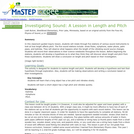
In this classroom guided inquiry lesson, students will rotate through five stations of various sound instruments to look at how length affects pitch. Student will develop a hypothesis, make observations, and draw a conclusion about what happens when the length of the vibrating sound source changes.
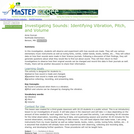
Students will investigate how sounds are made and changed, record their findings in their journal, share these findings with the class, and develop further questions about sound.
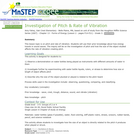
This is an activity demonstrating how pitch varies using water bottles, and allows students to investigate pitch further with rulers, straws, and water bottles.

This course is about the study of speech sounds; how we produce and perceive them and their acoustic properties. Topics include the influence of the production and perception systems on phonological patterns and sound change, students learn acoustic analysis and experimental techniques. Students taking the graduate version complete different assignments.
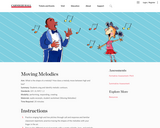
Students sing and identify melodic contours.
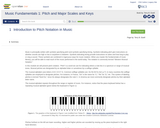
This collection is the first of five dealing with the rudiments of music.

This course is a survey of perceptual and cognitive aspects of the psychology of music, with special emphasis on underlying neuronal and neurocomputational representations and mechanisms. Basic perceptual dimensions of hearing (pitch, timbre, consonance/roughness, loudness, auditory grouping) form salient qualities, contrasts, patterns and streams that are used in music to convey melody, harmony, rhythm and separate voices. Perceptual, cognitive, and neurophysiological aspects of the temporal dimension of music (rhythm, timing, duration, temporal expectation) are explored. Special topics include comparative, evolutionary, and developmental psychology of music perception, biological vs. cultural influences, Gestaltist vs. associationist vs. schema-based theories, comparison of music and speech perception, parallels between music cognition and language, music and cortical action, and the neural basis of music performance.
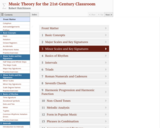
Music Theory for the 21st–Century Classroom is an openly–licensed online college music theory textbook that is meant to take the student from the basics of reading and writing pitches and rhythms through twelve–tone technique and minimalism over the course of four semesters. This text differs from other music theory textbooks by focusing less on four–part (SATB) voiceleading and more on relating harmony to the phrase. Also, in traditional music theory textbooks, there is little emphasis on motivic analysis and analysis of melodic units smaller than the phrase. Whenever possible, examples from popular music and music from film and musical theater are included to illustrate melodic and harmonic concepts, usually within the context of the phrase. Practice exercises (with answers), homework exercises, and practice tests are included.
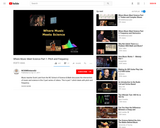
Part 1 of a three part series of videos explaining the connection between science and music. Part 1 Pitch and Frequency, Part 2 Pitch and Frequency continued, Part 3 Frequency and Harmonics
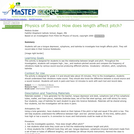
This activity is an investigation where students use tools to determine how the length of a sound source affects its pitch.